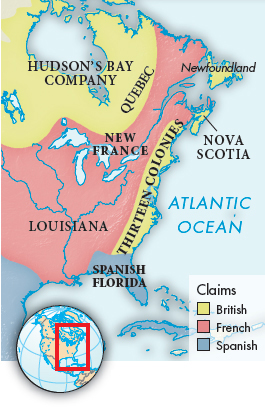Colonial Empires of England and France
England and France followed the Dutch in challenging Iberian dominance overseas. Unlike the Iberian powers, whose royal governments financed exploration and directly ruled the colonies, England, France, and the Netherlands conducted the initial phase of colonization through chartered companies with monopolies over settlement and trade in a given area.
After an unsuccessful first colony at Roanoke (in what is now North Carolina), the English colony of Virginia, founded at Jamestown in 1607, gained a steady hold by producing tobacco for a growing European market. In the 1670s English colonists from the Caribbean island of Barbados settled Carolina, where conditions were suitable for large rice plantations. During the late seventeenth century enslaved Africans replaced indentured servants as laborers on tobacco and rice plantations, and a harsh racial divide was imposed.
For the first settlers on the coast of New England, the reasons for seeking a new life in the colonies were more religious than economic. Many of these colonists were radical Protestants escaping Anglican repression. The small and struggling outpost of Plymouth Colony (1620) was followed by Massachusetts Bay Colony (1630), which grew into a prosperous settlement. Religious disputes in Massachusetts led to the dispersion of settlers into the new communities of Providence, Connecticut, Rhode Island, and New Haven. Because New England lacked the conditions for plantation agriculture, slavery was always a minor factor there.
As the English crown grew more interested in colonial expansion, efforts were made to acquire the territory between New England in the north and Virginia in the south. The goal was to unify English holdings and minimize French and Dutch competition on the Atlantic seaboard. The results of these efforts were the mid-
Whereas English settlements were largely agricultural, the French established trading factories in present-

French immigration to New Canada remained small compared with the stream of settlers who came to British North America; nevertheless, the French were energetic and industrious traders and explorers. Following the waterways of the St. Lawrence River, the Great Lakes, and the Mississippi River, they ventured into much of North America in the 1670s and 1680s. In 1673 the Jesuit Jacques Marquette and the merchant Louis Joliet sailed down the Mississippi as far as present-
In the first decades of the seventeenth century, English and French captains also challenged Spain’s hold over the Caribbean (see Map 19.2), seizing a number of islands. These islands acquired new importance after 1640, when the Portuguese brought sugar plantations to Brazil. Sugar and slaves quickly followed in the West Indies (see “Sugar and Early Transatlantic Slavery” in Chapter 16), making the Caribbean plantations the most lucrative of all colonial possessions.
The northern European powers also expanded in Africa and Asia. In the 1600s France and England — along with Denmark and other northern European powers — established fortified trading posts, or factories, in West Africa as bases for purchasing slaves and in India and the Indian Ocean for spices and other luxury goods. Thus, by the end of the seventeenth century, a handful of European powers possessed overseas empires that truly spanned the globe.